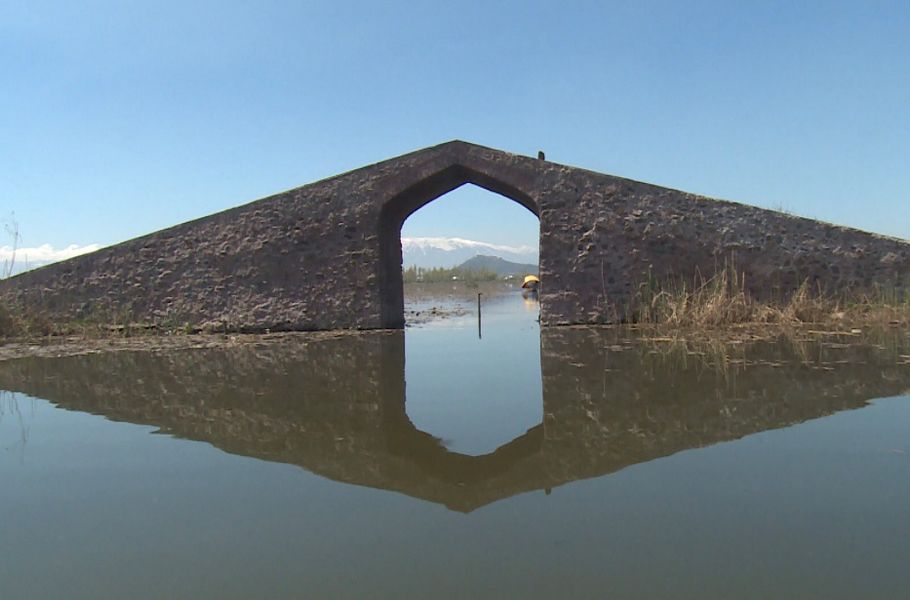
Kashmir’s Mughal-era camelback-shaped bridge restored to its glory

A seventeenth century camel hump-shaped bridge built in the middle of Srinagar’s Dal Lake has been restored to its glory with Germany’s substantial financial support and perseverance of Kashmir’s well-known conservation architects.
The camelback-shaped bridge, according to the pundits familiar with Kashmir’s architectural grammar and history, was built during the Mughal emperor Aurangzeb’s rule in the 1670s. The bridge, according to historians, was used by both the residents of Srinagar’s downtown areas like Rainawari as well as the pilgrims to reach Nishat.
In Kashmiri language, this particular bridge in the middle of the lake is called ‘Oont Kadal’.

Oont Kadal, according to the Srinagar-based conservation architect Saima Iqbal, is a stone masonry construction which was almost on the verge of a collapse. From the heritage point of view, it was important to restore the construction without fiddling with its originality. “This bridge has a unique typology and it enhances the Dal Lake’s beauty in multiple ways. It was important to preserve this unique bridge of outstanding global heritage value,” Saima Iqbal told The Federal.
Saima Iqbal is skilled in building conservation, urban planning and sustainable design. She has a master’s degree in Historic Preservation and Conservation from Oxford Brookes University. Presently, she works as Project Lead with the Kashmir chapter of Indian National Trust for Art and Cultural Heritage (INTACH).
Kashmir’s Oont Kadal is also a visitor’s delight. The bridge attracts both regional and foreign tourists, many of whom also take a boat ride to reach there and take pictures with the Nishat Gardens in the backdrop.
Architect Saima Iqbal said that one can frame the camel hump-shaped bridge from the Nishat Gardens and vice versa. “It is picturesque. Apart from taking selfies here, the bridge is a wedding photography destination for some. Tourists take pictures of the arch and the bridge. It is very satisfying to be here,” she said, adding that “the bridge meets all the architectural parameters.”
Also read: Meet Kashmir’s millennials who strum, sing its traditional tunes to the world
Besides this, the Oont Kadal forms an important part of the public realm that constitutes the combined environment of the lake, Zabarwan mountain range and the Nishat Gardens.
In October 2018, Germany’s Deputy Ambassador to India, Dr. Jasper Wieck, and Cultural Officer, Federal Republic of Germany Thomas Schmidt had signed an agreement with INTACH at Shalimar, one of Kashmir’s popular Mughal gardens, for the restoration of camel bridge.
The cultural wing of the German Embassy stationed in New Delhi in late 2018 had sanctioned € 40,000 (approx ₹ 35 lakh) with the aim to preserve and restore the glory of the 350-year-old Mughal-era bridge inside the famed lake.
After the restoration of Oont Kadal, a stone plaque prepared by the German Embassy reads: ‘Restoration of historic Oont Kadal. Built in the later period of AD 1670s. Project supported by The Embassy of Federal Republic of Germany, New Delhi & Lakes and Waterways Development Authority. Project executed by INTACH, Kashmir Chapter (October 2018-April 2019).’
Also read: Bollywood aims to shoot more films in Kashmir, but can it improve its image?
Saleem Beg, convenor of J & K chapter INTACH, said the German Embassy had previously also contributed in preservation and restoration of Paper Mache Ceiling at the black Pavilion or “Divan-e-Khaas” of the Shalimar Gardens. “We were very concerned about the dilapidated condition of ‘Oont Kadal’. No funding was available. But then the German Embassy’s cultural wing expressed the desire to work for the restoration of this bridge of high architectural value,” Beg told The Federal.
Beg had visited Germany on the country’s national day and discussed the proposal further. “After discussions, the Germans provided both material and non-material help and we were able to restore this significant symbol of cultural heritage,” he said.
In September 2013, the former German ambassador Michael Steiner had visited Srinagar along with music maestro Zubin Mehta. The maestro had performed at a concert inside the Shalimar Gardens. Kashmiri opinion makers were divided on the event sponsored by the German Embassy, as some believed that the Kashmir Valley should welcome the concert while others maintained that New Delhi in collaboration with Germany was trying to paint deceptive normalcy in Kashmir through such concerts.

